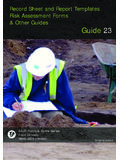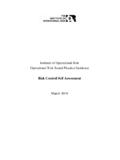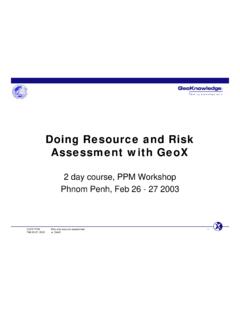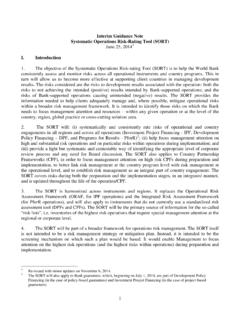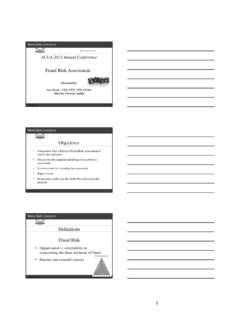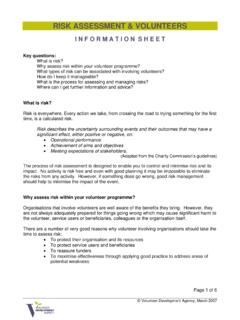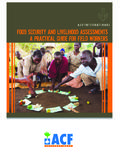Transcription of The World Bank Risk Assessment Methodology
1 1 The World bank Risk Assessment Methodology 1. Background World bank has attached high importance to money laundering and terrorist financing risk Assessment from the early years of the recognition of risk based approach in AML/CFT area and has actively helped client countries to assess these risks . In doing so, the World bank developed two national risk Assessment tools (First Generation and Second Generation National Risk Assessment tools) as well as national risk Assessment process, with a view to facilitate the risk Assessment even in the countries where the data and statistics are limited. The World bank tools are essentially, although not limited to, self- Assessment tools in order to help the countries develop their capacity to collect and analyse the useful data, statistics and information and introduce a risk based approach.
2 2. The NRA Tools Developed by the World bank First Generation Tool First Generation tool is an Excel-based template that was developed initially by the World bank and later integrated into the Strategic Implementation Programming (SIP) framework, which is a joint initiative by the World bank and Asia Pacific Group on Money Laundering (APG). In this regard, refinement of the first generation NRA tool has greatly benefited from participation of APG members and partners. The first generation NRA tool is offered to client countries by the World bank also on a stand-alone basis as it may be suitable to them, taking into account their size of economy, sophistication and depth of financial sector and Designated Non-Financial Businesses and Professions (DNFBPs), and complexity of ML/TF crime, among others.
3 The first generation NRA tool utilises a matrix approach in assessing the ML and TF risks . The risk Assessment template focuses on the Assessment of threat and vulnerabilities as the main components of the ML/TF risk. SIP NRA template is an Excel file with 5 Assessment areas (ML Prevailing Crime Type/TF Threat Analysis, Legal/Judicial/Institutional Framework, Economic and Geographical Environment, Financial Institutions and DNFBPs), accompanied by summary findings. Each of the Assessment areas contains carefully selected indicators to assess threats and vulnerabilities. Two separate risk assessments are undertaken on ML risk and TF risk, using the symmetric risk Assessment structure.
4 The worksheets designed for the ML/TF Assessment consists of following templates: Table 1 National ML Risk Assessment template National TF Risk Assessment template Threat Analysis 1- Prevailing Crime Type Vulnerability Analysis 2- Legal/Judicial/Institutional Framework 3- Economic and Geographical Environment 4- Financial Institutions 5- DNFBPs Threat Analysis 1- TF Threat Analysis Vulnerability Analysis 2- Legal/Judicial/Institutional Framework 3- Economic and Geographical Environment 4- Financial Institutions 5- DNFBPs The main difference between ML and TF risk Assessment templates is the threat analysis. The objective of ML Threat Analysis is to understand what type of predicate offenses pose a ML threat in jurisdiction based on data and other information collected, and identify origins (both domestic and foreign) and methods of ML.
5 Outcome of such threat analysis would be useful for law enforcement agencies (LEAs) to prioritise their actions. It is also useful for FIU and covered institutions to understand the type of crimes that generate illicit proceeds and different methods of money laundering. On the TF risk Assessment side, TF threat analysis also attempts to capture the statistics and any other information but on TF cases and assesses the level and sources of TF threats. Vulnerability analysis section consists of four Assessment matrices, each of which focuses on vulnerabilities arising from different areas. Legal/Judicial/ Institutional Framework and Economic and Geographical Environment assesses the vulnerabilities arising from the factors at the national level, while Financial Institutions and DNFBPs focuses on vulnerabilities posed by financial institution and DNFBP categories that are present in assessed jurisdiction.
6 The structure of Financial Institutions and DNFBPs matrices are different from the others, and they are designed to enable Assessment and comparison of the inherent vulnerabilities as well as net vulnerabilities (after taking into account the control measures) arising from various sectors, institutions or professions. Vulnerability Assessment in ML and TF risk Assessment templates are very similar and differ in limited number of indicators. This effort was intentionally made in order to allow comparison of ML and TF risk faced by the country. For each of the indicators in the matrices, a threat, vulnerability or risk level is assessed based on the information and statistics provided.
7 Available information and statistics are filled into designated boxes in the templates. Most of these boxes are designed to capture a short summary of the information/justification. A detailed write up that elaborates the grounds and justification for each Assessment , is required in order to ensure the quality and credibility of the assessments. The template includes pre-identified and carefully selected indicators to assess the ML/TF risks ; however, the template can be customised by adding new indicators or amending existing ones, to reflect each country s unique environment. 3 Second Generation Tool The Second Generation NRA Tool has been developed by the World bank with a view to enable more rigorous and sophisticated risk Assessment .
8 This NRA tool was modeled on the Bayesian Network which utilises the laws of probability at its core of the modeling and analyses the sources and causes of risk. Strong logical sequence of events and causal relations between variables affecting risk is carefully modeled. This enables capturing main drivers of the money laundering risk, formularising the complex environment of money laundering taking into account the interactions among various components of risk and vulnerability and generating a final measure of the risk/vulnerability level. In order to make the tool user friendly and easily accessible, this Second Generation tool has been remodeled based on excel and using weighted averages instead of probabilities, while keeping the logic and concept of ML risk Assessment built from the initial Bayesian Network approach.
9 The Second-Generation NRA tool is a knowledge-based diagnostics and decision making tool that can assist decision-makers to assess and analyse money laundering risk in a jurisdiction. The tool provides a means to understand sources of vulnerability in a country and how various factors that influence the vulnerability are inter-related. The tool can also be used to iteratively observe and analyse the effects of various policy options based on scenarios. For example, the impact of actions (individually or collectively) to reduce the vulnerability can be determined. The model defines the ML Risk as a combination of national threat and national vulnerability.
10 The national threat module is the Proceeds of Crime exercise that provides guidance to countries to assess the ML threat. In assessing national vulnerability, a number of variables are evaluated as main drivers (input variables) of vulnerability to ML. All these input variables constitute the building blocks of a network which ultimately feeds into the national vulnerability node. The general structure of the model is provided in figure 1. Figure 1 Second Generation NRA Tool consists of 8 modules. Two main modules, namely National Threat Analysis and National Vulnerability Analysis modules that feed into the National ML risk and determine the country s position on the risk map provided in figure 2.










